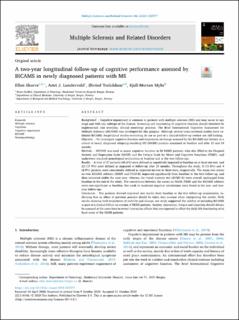| dc.contributor.author | Skorve, Ellen | |
| dc.contributor.author | Lundervold, Astri | |
| dc.contributor.author | Torkildsen, Øivind | |
| dc.contributor.author | Myhr, Kjell-Morten | |
| dc.date.accessioned | 2021-06-24T08:54:29Z | |
| dc.date.available | 2021-06-24T08:54:29Z | |
| dc.date.created | 2020-11-08T13:45:13Z | |
| dc.date.issued | 2020 | |
| dc.Published | Multiple Sclerosis and Related Disorders. 2020, 46:102577 1-7. | |
| dc.identifier.issn | 2211-0348 | |
| dc.identifier.uri | https://hdl.handle.net/11250/2761051 | |
| dc.description.abstract | Background: Cognitive impairment is common in patients with multiple sclerosis (MS) and may occur at any stage and with any subtype of the disease. Screening and monitoring of cognitive function should therefore be implemented into everyday clinical neurology practice. The Brief International Cognitive Assessment for Multiple Sclerosis (BICAMS) was developed for this purpose. Although several cross-sectional studies have validated BICAMS, longitudinal studies evaluating its use as part of a clinical follow-up routine are still lacking.
Objective: To investigate cognitive function and trajectories of change assessed by the BICAMS test battery in a cohort of newly diagnosed relapsing-remitting MS (RRMS) patients examined at baseline and after 12 and 24 months.
Methods: BICAMS was used to assess cognitive function in 58 RRMS patients, who also filled in the Hospital Anxiety and Depression Scale (HADS) and the Fatigue Scale for Motor and Cognitive Functions (FSMC), and underwent standard neurological evaluations at baseline and at the two follow-ups.
Results: A total of 27 patients (46.6%) were defined as cognitively impaired at baseline on at least one test, and 22 (37.9%) were defined as impaired at follow-up after 24 months. Throughout the study, 8 (13.8%) and 4 (6.9%) patients were consistently defined as impaired on two or three tests, respectively. The mean raw scores on two BICAMS subtests (SDMT and CVLT-II) improved significantly from baseline to the first follow-up, and then remained stable the next year, whereas the visual memory test (BVMT-R) were overall unchanged from baseline to the end of the study. The correlations between the scores on HADS, FSMC and the BICAMS subtests were non-significant at baseline, but weak to moderate negative correlations were found at the one- and two-year follow-ups.
Conclusion: The patients showed improved test results from baseline to the first follow-up examination, indicating that an effect of previous practise should be taken into account when interpreting the results. With results showing both trajectories of stability and change, our study supported the validity of including BICAMS as part of a clinical follow-up routine of RRMS patients. Anxiety, depression, fatigue and cognition should always be assessed at the same time to reveal interaction effects that are expected to affect the daily-life functioning of at least some of the RRMS patients. | en_US |
| dc.language.iso | eng | en_US |
| dc.publisher | Elsevier | en_US |
| dc.rights | Navngivelse 4.0 Internasjonal | * |
| dc.rights.uri | http://creativecommons.org/licenses/by/4.0/deed.no | * |
| dc.title | A two-year longitudinal follow-up of cognitive performance assessed by BICAMS in newly diagnosed patients with MS | en_US |
| dc.type | Journal article | en_US |
| dc.type | Peer reviewed | en_US |
| dc.description.version | publishedVersion | en_US |
| dc.rights.holder | Copyright 2020 The Authors | en_US |
| dc.source.articlenumber | 102577 | en_US |
| cristin.ispublished | true | |
| cristin.fulltext | original | |
| cristin.qualitycode | 1 | |
| dc.identifier.doi | 10.1016/j.msard.2020.102577 | |
| dc.identifier.cristin | 1845912 | |
| dc.source.journal | Multiple Sclerosis and Related Disorders | en_US |
| dc.source.40 | 46:102577 | |
| dc.identifier.citation | Multiple Sclerosis and Related Disorders. 2020, 46:102577 | en_US |
| dc.source.volume | 46 | en_US |

